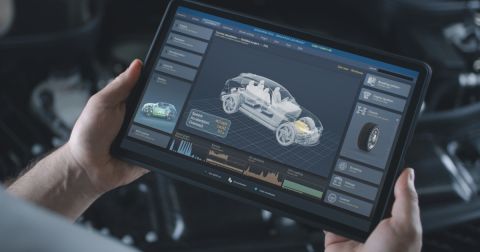Breaking Down Silos with Collaborative Requirements Management Software

Picture a football team where players run different playbooks. Chaos, right? Yet this scenario mirrors how many electronics companies manage their product development, with teams working in isolation from conflicting requirements. Hardware engineers craft specifications in spreadsheets, software teams track user stories in agile tools, and quality teams maintain test cases in separate systems. The result? A discordant product development process plagued by miscommunication, delays, and costly rework.
The electronics industry has historically viewed these product development divisions as unavoidable. But in an era where products combine sophisticated hardware, software, and firmware–often supporting safety-critical applications–this fragmented approach across multiple disciplines is increasingly risky. When a single product might contain contributions from dozens of engineers across multiple disciplines, maintaining alignment when working with disconnected systems becomes nearly impossible.
The solution lies not in better documentation or more meetings but in fundamentally changing how teams collaborate around requirements. Modern collaborative requirements management tools are transforming how electronics companies develop products. Multi-discipline requirements management software replaces departmental barriers with an unimpeded flow of information and real-time coordination.
Managing Requirements and The Costs of Siloed Development
Traditional electronic product development often resembles a relay race, with each team passing the baton to the next. Hardware engineers define specifications based on the electrical design, software developers code to those requirements, and quality assurance teams test the final product. While this linear approach might seem logical, it often results in:
- Communication gaps: Critical system design requirements and engineering decisions become distorted or lost as information passes through multiple teams and systems.
- Delayed feedback: Problems discovered during later development stages require extensive backtracking and costly redesigns that could have been avoided earlier.
- Lack of context: Teams working in isolation often miss crucial interdependencies between subsystems, leading to integration problems and suboptimal design decisions.
- Inadequate requirements traceability: Without proper linking between initial requirements and final implementation, teams struggle to verify that the end product meets original specifications, making it difficult to track changes and ensure compliance throughout the development lifecycle.
- Duplication of effort: Without clear visibility into parallel work streams, multiple teams unknowingly tackle the same problems, wasting valuable engineering resources.
- Missed opportunities for innovation: When teams operate in silos, they miss chances to combine expertise and insights that could lead to breakthrough solutions.
These problems inherent in siloed operations cascade through the development cycle, leading to missed deadlines, budget overruns, and products that fall short of market expectations. In today's electronics industry, companies can no longer afford the luxury of managing requirements with these fractured development approaches.
Agile Requirements Management: The Collaborative Advantage
A collaborative requirements management system creates a shared space where all stakeholders can contribute, review, and refine requirements throughout the product lifecycle. This approach offers several key benefits:
- Real-time visibility: All team members can access the latest requirements, reducing confusion and ensuring everyone works toward the same goals.
- Cross-functional input: Hardware, software, and quality teams can provide insights early in the process, catching potential issues before they become costly problems.
- Requirements traceability: Changes to requirements are tracked and linked to affected components, making it easier to assess the impact of modifications.
- Streamlined approvals: Collaborative requirements management tools often support workflows that speed up review and approval processes.
- Knowledge retention: A centralized system serves as a repository of decisions and rationale, valuable for future projects and onboarding new team members.
Requirements Management Software: A Unified Platform for Electronics Development
To successfully implement collaborative requirements management, you'll need a requirements management software platform that can unite teams, tools, and workflows while maintaining each group's specialized capabilities. Traditional document management systems lack the specific features needed to support agile development for hardware, and project management tools miss the deep technical integration required for hardware and software development. What's needed is purpose-built requirements management software that understands the unique demands of electronic design while breaking down the walls between disciplines. A leading example is Altium Develop requirements management tools. Altium Develop provides full visibility into requirements for all stakeholders throughout the project's lifecycle, enabled by:
- Centralized requirements management: All requirements are stored in a single, accessible location, eliminating multiple, often conflicting, sources of information.
- Direct links to design elements: Requirements are connected directly to schematics, PCB layouts, and documentation, creating a clear trail from concept to implementation.
- Real-time updates: Requirement changes automatically propagate throughout the project, ensuring all team members work with the latest information.
- Parametric requirements: Technical values can be embedded within requirements, enabling automatic and continuous verification against design parameters.
- Version control: The system tracks changes over time, allowing teams to compare versions and understand the evolution of a design.
By integrating requirements management with design tools, Altium Develop bridges the gap between different disciplines in electronics development. This integration is particularly valuable in industries with complex regulatory environments, such as medical devices or automotive electronics, where requirements traceability is paramount.
Implementing a Collaborative Approach
Shifting to a collaborative requirements management system requires more than just new software – it calls for a change in organizational culture. Here are steps to facilitate this transition:
- Assess current workflows: Identify where silos exist and how they impact product development.
- Define clear objectives: Establish goals for the new system, such as reducing time-to-market or improving product quality.
- Choose the right tool: Select a platform that integrates with existing systems and supports your specific industry needs.
- Train and support: Provide comprehensive training and ongoing support to ensure adoption across all teams.
- Encourage cross-functional communication: Foster an environment where diverse perspectives are valued and sought out.
- Measure and iterate: Track key performance indicators to gauge the system's impact and refine processes as needed.
Collaborative Success in Action
Organizations that have implemented collaborative requirements management systems generally report significant improvements across their product development process. Common benefits include:
- Reduced development time due to earlier detection and resolution of potential issues
- Faster implementation of customer change requests, thanks to improved traceability
- Increased satisfaction among cross-functional teams regarding project communication
- Fewer late-stage design changes, which reduces costly rework
A unified platform offers companies the ability to enhance how they manage complex projects, responding to changes quicker and maintaining clear communication throughout the development process.
Looking Ahead: Bringing It All Together
As electronics become more complex and integrated, the need for collaborative development practices will grow. In the near future, we'll be seeing:
- AI-assisted requirement analysis: Machine learning algorithms could help identify potential conflicts or optimization opportunities in real-time.
- Extended reality (XR) collaboration: Virtual and augmented reality tools may enable more intuitive ways for distributed teams to visualize and interact with designs.
- Blockchain for compliance: Distributed ledger technology could provide immutable records of design decisions, enhancing traceability for regulatory purposes.
- IoT integration: As more products connect to the IOT, requirements management systems may need to account for ongoing updates throughout the product's lifecycle.
From Silos to Success: The Collaboration Imperative
Collaborative requirements management breaks down silos so teams can realize the full potential of cross-functional development. By creating an environment where information and expertise are freely shared and utilized, companies can get better products to market faster with greater confidence.
Experience seamless collaboration and accelerate your development process. Try Altium Develop requirements management tools today to unlock the power of cross-functional teamwork!













